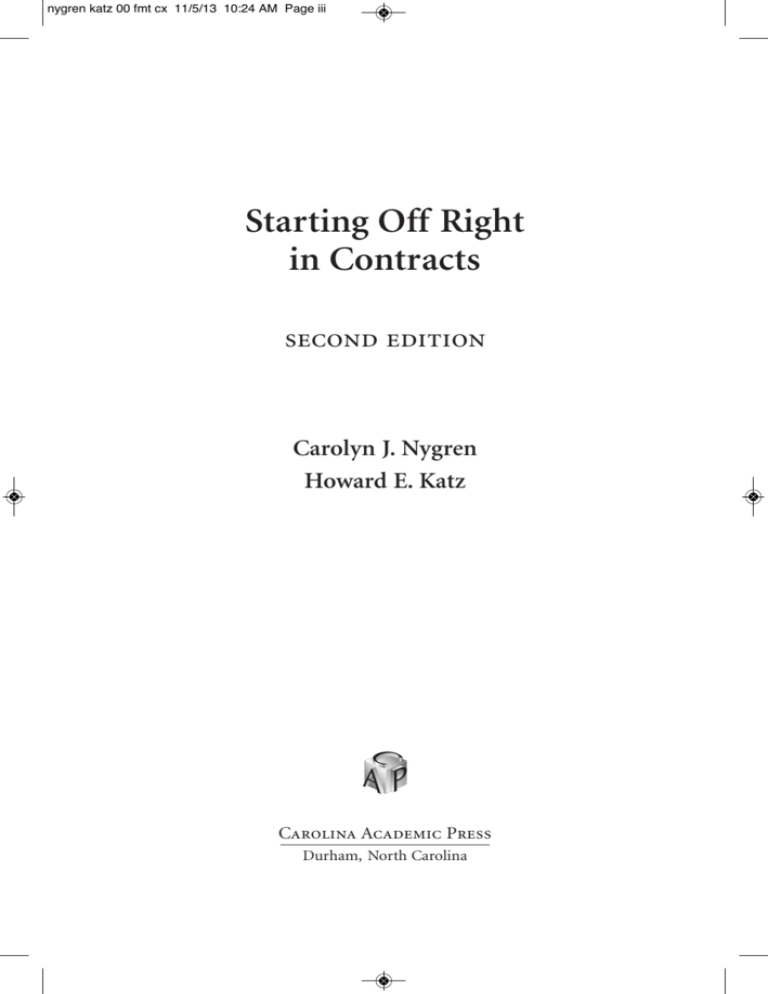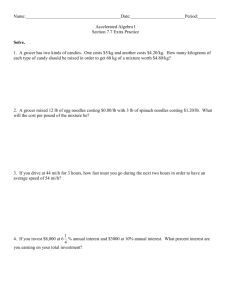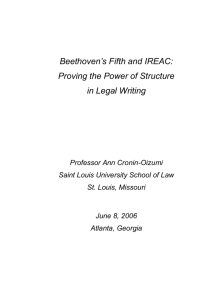
nygren katz 00 fmt cx 11/5/13 10:24 AM Page iii
Starting Off Right
in Contracts
second edition
Carolyn J. Nygren
Howard E. Katz
Carolina Academic Press
Durham, North Carolina
nygren katz 00 fmt cx 11/5/13 10:24 AM Page iv
Copyright © 2014
Carolyn J. Nygren and Howard E. Katz
All Rights Reserved
Library of Congress Cataloging-in-Publication Data
Nygren, Carolyn, 1942- author.
Starting off right in contracts / Carolyn J. Nygren, Howard E. Katz.
-- Second edition.
pages cm
ISBN 978-1-59460-827-8 (alk. paper)
1. Contracts--United States--Outlines, syllabi, etc. 2.
Contracts--Study and teaching--United States--Outlines, syllabi, etc.
3. Law--Study and teaching--United States. I. Katz, Howard E.,
author. II. Title.
KF801.Z9N94 2013
346.7302'2--dc23
2013036603
Carolina Academic Press
700 Kent Street
Durham, North Carolina 27701
Telephone (919) 489-7486
Fax (919) 493-5668
www.cap-press.com
Printed in the United States of America
nygren katz 00 fmt cx 11/5/13 10:24 AM Page v
Contents
Foreword
ix
Introduction
xv
Chapter 1 · Information Necessary for Law School Survival
Case Reading— A Time-Consuming Task
1. Cases were not written as teaching materials
2. Cases are full of words you don’t know
Casebooks— A Mystery
1. The cases in your casebook are from many jurisdictions
2. Casebook editors often try to “hide the ball”
The Ultimate Goal
Taking Notes on Cases — Briefs?
Cases and Classes
Note Taking— Keeping the Goal in Mind
More About What Happens in Class
Outlining
Law School Testing— A Shock
Grading— More Mystery
Answering Exam Questions
Practicing the Method
What about IRAC?
Chapter 2 · Contract Formation
Case Reading and Note Taking
Outlining
Is there an offer?
Can the offer be revoked?
Was the power of acceptance terminated?
3
3
3
4
5
5
6
6
7
10
11
12
13
16
19
21
24
24
27
28
32
33
34
35
v
nygren katz 00 fmt cx 11/5/13 10:24 AM Page vi
vi
CONTENTS
Was the offer accepted?
UCC Differences
Test Taking and Grading
Sample Questions
Unilateral Contract
Option Contract
Bilateral Contract with Counteroffer
Unilateral Contract
Consideration and Promissory Estoppel
Analysis Hints
Consideration
Promissory Estoppel
Sample Questions
Chapter 3 · Defenses
Defenses that Arise at the Time of Formation
Analysis Hints
1. Defenses easy to spot, easy to analyze
2. Defenses usually easy to spot, harder to analyze
3. Defenses hard to spot, usually easy to analyze
4. Defenses easy to spot, policy analysis required
Effect of Establishing a Valid Defense
Defining What Is and Isn’t a Defense
Capacity— Infancy
Capacity— Mental Incapacity
Capacity— Intoxication
UCC
Misunderstanding
Mutual Mistake
Unilateral Mistake
UCC
Misrepresentation
Intentional Misrepresentation— Fraud
Duress
Unconscionability
Statute of Frauds
UCC
Sample Questions
Defenses that Arise after Formation
Analysis Hints
35
37
38
48
48
54
58
67
69
69
70
73
73
85
87
87
87
88
88
88
89
89
89
90
90
90
91
91
91
92
92
93
93
93
94
95
96
106
106
nygren katz 00 fmt cx 11/5/13 10:24 AM Page vii
CONTENTS
Impossibility
Impracticability
Frustration of Purpose
UCC
Sample Question
Other Categories of Arguments to Avoid Enforcement (not true
affirmative defenses)
Conditions
Parol Evidence Rule
Summary of the Rule
Step-by-Step Analysis
UCC
Rights and Obligations of Third Parties
Third Party Beneficiary
Assignment of Rights
Delegation of Duties
UCC
Sample Questions
vii
106
107
107
108
109
112
113
116
116
117
118
118
119
120
120
121
121
Chapter 4 · Formation and Defense Questions
131
Chapter 5 · Breach and Remedies
Analysis Hints
Breach
UCC
Remedies
Common Law Compensatory Damages
Liquidated Damages
Alternative Measure— Reliance
Alternative Measure— Restitution
Equitable Remedy— Specific Performance
UCC
Sample Questions
Chapter 6 · Confronting Your Final Exam
Contracts — The Big Picture
Formation
Defenses (arising at the time of formation)
Defenses (arising after formation)
Other Categories of Arguments to Avoid Enforcement (not
true defenses)
Breach
139
139
140
141
141
141
142
143
143
144
144
145
159
160
160
161
161
161
162
nygren katz 00 fmt cx 11/5/13 10:24 AM Page viii
viii
CONTENTS
Alternative Theories of Recovery
Remedies
Using Old Exams to Prepare
Final Thoughts
162
162
162
163
nygren katz 00 fmt cx 11/5/13 10:24 AM Page ix
Foreword
How to Use This Book
This book is designed to provoke thought and discussion. It will suggest organization, analysis, and writing techniques helpful to you from the very first
day of class. As you become more sophisticated in your knowledge of the law,
your analysis and writing skills will also become more sophisticated. This book
can only give you a foundation, but our hope is that by providing you with
such a foundation, everything you do in your first weeks and months of law
school will be done with greater purpose, direction, understanding, and efficiency. Nevertheless, we encourage you to modify our rule statements, definitions, and listings of elements, to create your own methods of organizing
the material, to challenge our analysis of the facts, to add philosophical and
policy considerations, and even to come to different conclusions. In order to
help you, the methods we suggest have to be seen as a starting point, which
can be adapted to your needs and to the expectations of your professors.
The book begins with a short introduction entitled “The Study of Contracts
is Unique.” It discusses how studying contracts is different from studying any
other course. These few pages will give you the “Goodyear Blimp overview” of
the study of contract law. It is important that you have a framework into which
you can fit the rules you will learn and the cases you will read. You may want
to return to these pages throughout the course, to see how the topic you are
studying at any given time fits into the bigger picture.
Chapter One provides you with information necessary for law school survival.
Chapter Two covers offer (including revocation and termination), acceptance,
consideration, and promissory estoppel. You may want to read the entire chapter at the outset to see how all of the sub-topics are related (and to help put your
course reading in context), or you may want to wait until you have covered each
of the topics more fully in class before reading each part of the chapter.
ix
nygren katz 00 fmt cx 11/5/13 10:24 AM Page x
x
FOREWORD
Chapter Three covers defenses and related arguments. We have divided this
topic into defenses based on circumstances that were true at the time of the
formation of the contract, defenses based on events that took place after formation, and other arguments that can be raised to avoid enforcement of a contract that are not true affirmative defenses. Chapter Four introduces you to
multi-issue exam questions. Chapter Five covers breach and remedies, and also
includes more multi-issue questions.
Chapter Six is meant to be read now and shortly before your final exam.
This book cannot prepare you for every question asked by every professor.
Rather, its purpose is to provide you with an organized, deliberate approach,
and the building blocks necessary for you to construct your own answers.
Chapter Six contains suggestions for exam preparation (including a checklist
of contract law issues), and some hints for strategizing during your actual
exam.
The organization of topics in this book may be different from the organization in your casebook. For example, although your casebook may include
revocation as a subsection of termination, it is given a separate heading in this
book, because complete and efficient analysis of contract formation problems
requires special attention to revocation. The organization of the chapter on
defenses is also non-traditional. It provides you with a simple and efficient approach to use when you are analyzing a complicated fact pattern. The chapter
then goes on to discuss other arguments that can be raised by one party to try
to avoid enforcement of a contract that are not typically considered to be true
affirmative defenses. The order of topics in your casebook reflects the author’s
idea of the best way to introduce and teach the substance of contract law, but
that order may not be the most effective way to analyze a contracts problem.
Our goal is to provide you with a format that will help you to organize the
course material and to make use of it on an exam. As you cover particular topics in your class, you should add what you learn to the framework we have
provided. Some courses begin with contract formation, others with theories
of recovery or with remedies. Regardless of where the course begins, the successful law student recognizes that sometimes the course material has to be reorganized to best facilitate applying it to an exam question. Use our framework
as a starting point, and modify it in light of your particular course and professor.
The primary purpose of this book is not to teach you the law. Although
many students find they need more than their casebooks and class notes to
learn the rules of law, your bookstore already has various commercial outlines
and hornbooks to help you in that regard. We have found that most students
nygren katz 00 fmt cx 11/5/13 10:24 AM Page xi
FOREWORD
xi
learn more than enough law, in terms of knowing the rules. But what many
students find more challenging is figuring out what to do with all those rules,
how to organize them in a usable way, and how to apply them the way the professor wants that to be done. That is the focus of this book. Assuming you have
learned the law, this book will enable you to effectively demonstrate your
knowledge on an exam.
Each chapter begins with an explanation of useful techniques used to approach problems in a given topic. This will be followed by a draft outline of
the topic. The draft outline consists of rule statements, exceptions, and some
common applications. You can add the information you’ve learned in class,
and from the cases you’ve read showing how the rules have been interpreted.
With the exception of the Uniform Commercial Code (UCC), the rules in contract law have been centuries in the making, and no two professors (and no
two commercial outlines) state them in exactly the same way. Don’t let this
throw you. The basic components of the rules are pretty much the same from
professor to professor and hornbook to hornbook. Because there is no one
universally accepted phrasing of the rules, it’s okay to compose a rule that
makes sense to you, so long as it contains the accepted elements and captures
any particular approach your professor takes. If your professor gives you a specific rule statement, you would be wise to use it. Each chapter will also include
sample exam questions, sample notes for an answer, and some answers.
This book is designed to give you organizational strategies for answers, not
a complete explanation of every rule and every doctrine. It can be particularly
useful in a study group, and in Chapter Six we suggest how members of a study
group can work together on exam preparation. The material in each of the
chapters can be used throughout the semester as your study group meets, or
near the end of the semester as you begin your final review.
The approach we suggest and demonstrate throughout the book is designed
to ensure that a student addresses all the issues in an exam question. We explain here, and again later in the book, how to answer a question by first doing
a “top-down” analysis, going step-by-step through each rule, element, or subelement that applies to a particular topic. Then we suggest that you proceed
“bottom-up,” looking more closely at each fact in the question to make sure
that you have not missed any possible significance.
At some point before you begin actually writing your exam answer (either
after you have done your top-down analysis, or after you have done both the
top-down and bottom-up analysis), we suggest you underline or cross out the
words in the fact pattern that you have already applied to various rules. You
should then look at the unmarked words to see if you have missed something
nygren katz 00 fmt cx 11/5/13 10:24 AM Page xii
xii
FOREWORD
important. Sometimes words you have not marked are there merely to advance
the story of the fact pattern, but often they may prompt you to notice an issue
you might have missed. So why not cross out those words the first time you
use them? Because sometimes the same fact can fit into your answer in more
than one place. This basic approach — first, going step-by-step (top-down),
and second, focusing more closely on the facts (bottom-up)— is an important
exam technique for many students. However, this approach cannot be successfully employed for the first time during an actual exam. It requires practice. So we provide the opportunity to practice this approach in each chapter.
Here is one suggested way to use this book: After each sample answer, there
is another copy of the question. We provide a second copy of the question because many law students seem to feel compelled to underline words in a question the first time they read it. With another copy of the question provided,
you will have a clean copy available for you to practice giving your answer. We
suggest that you read the Notes for Answer, and then the sample answer, as
many times as necessary in order to understand our approach. Then read the
copy of the question. First, apply the top-down method of reading the facts
given to determine what aspect or aspects of contract law are likely to be involved. Then, for each topic you have identified, try to recall everything you
know about it. That means each basic rule or definition, of course. But it also
means everything else you learned about the rule: limitations, common applications, and the like. Once you have recalled everything you know about
that topic, write down a quick outline. This outline is, in effect, an inventory
of all the things the legal system considers relevant for that topic, and thus the
things that must be demonstrated to determine whether or not the rule applies.
Once you have identified what must be demonstrated, you look at the new
facts you have been presented with in the exam question and apply those facts
to the existing rules, elements, policy arguments, etc. That’s what we mean by
a top-down analysis: you take what you know about a topic (the law), go
through it in a step-by-step manner, and apply the new facts to what you already know. Then, after having done this top-down analysis, you should do a
bottom-up analysis. This means taking another close look at each fact, to consider what legal rule or rules that fact suggests to you (even if you have already
applied that fact to one or more rules doing your top-down analysis). At some
point, as mentioned earlier, you might want to underline the words from the
question that you have already used in your top-down draft of an answer. Underlining is better than crossing the words out, since a given fact might apply
to more than one rule or element.
nygren katz 00 fmt cx 11/5/13 10:24 AM Page xiii
FOREWORD
xiii
The outlines and suggested answers we have provided are intended as a starting point. Using the notes you have from your casebook reading and from
class, see if there are any issues or sub-issues we did not include in our Notes
for Answer and Sample Answer, and add those to your analysis. The cases you
have read or the notes you have taken may modify what we have said, or might
present a rule in a different manner. If so, you should obviously take that into
account in how you will learn the material for your course. After you have
added to the Notes for Answer, you may want to put the book answer out of
sight. Put the question with the underlinings you have made and your modified notes in front of you. Write out your own answer to the question, taking
as much time as you need to be satisfied with your work. You may want to
write the answer again, but using less time. We have left some questions without answers so that you can practice on your own or with a study group. Most
professors do not provide a format for a model exam answer. We are suggesting a generic format that can be adapted to fit most classes. If your professor
gives you an answer format that differs, that is the one you should use.
Most students find it useful to devote from one-third to one-half of the time
allocated for each question on an exam to thinking, planning, and writing
down preliminary notes on scratch paper. Once you have done so, you must
be able to write your actual answer quickly. Writing answers to exams is a skill,
and as with any other skill, the best results are achieved by practice. Although
practicing writing and rewriting simple answers may seem mundane, the time
is well spent. The more complicated questions on a law school exam are usually no more than a combination of simpler questions. Though more complicated questions will require even better organization, you will find that if you
follow the systematic approach presented in this book, much of that organization will come naturally (with practice).
You can expect this book to help you in four ways:
1. We give you draft outlines, so that you don’t have to agonize over starting your own.
2. We provide techniques for reading fact patterns successfully.
3. We make suggestions for how to organize your answers coherently on
exams, using a step-by-step approach.
4. We supply sample questions and suggested answers for each topic so you
can practice your writing.
nygren katz 00 fmt cx 11/5/13 10:24 AM Page xv
Introduction
The Study of Contracts
Is Unique
Contracts is the only course in the first year of law school in which almost
every case and every fact pattern presents the same central issue: was there an
enforceable contract between the parties? Notice that the word “enforceable”
usually does not mean that one party will be forced to actually perform what
was promised. Rather, contract law contemplates that if there is an enforceable contract that has been breached, the breaching party will be forced to
compensate the other party for the failure to perform. Since the course is filled
with many rules with many details and many exceptions, it is easy to forget
that it is essentially a one-issue course. Of course if there is an enforceable contract, then two other issues present themselves: first, did one (or both) parties
breach the contract, and, second, if so, what remedies are available to the nonbreaching party?
The cases in your casebook represent abnormal situations. The business
world is full of contractual disputes that never result in litigation, and many
more contracts that never give rise to dispute at all. The cases you will study
are examples of those rare situations where relationships and other means of
amicable dispute resolution have failed.
Unlike tort remedies, generally contract remedies are not affected by the
notion of fault. Some of the cases you will read will be examples of good faith
attempts at performance that failed, while others represent intentional refusals
to perform. The following is an example of the latter:
Tamara’s Tomato Patch (Tamara’s) is a small farm that grows only tomatoes. It sells some of the tomatoes at its roadside stand, but most of the tomatoes are sold to The Green Grocer (Grocer), a large produce market. Tamara’s
xv
nygren katz 00 fmt cx 11/5/13 10:24 AM Page xvi
xvi
INTRODUCTION
and Grocer entered into an agreement in January, which specified the variety
of tomato Grocer will buy, the minimum size and degree of ripeness, the quantity, and the price ($.50 per pound). This agreement means that each party
takes a certain amount of risk, but also gets a certain amount of security. The
growing season may be wonderful, there may be a glut of tomatoes, and Grocer could buy the tomatoes from other farmers for $.30 per pound. On the
other hand, the growing season may be terrible, there may be a shortage of
tomatoes, and Tamara’s could sell all its tomatoes at its roadside stand for $.95
per pound. The agreement commits both parties to a predetermined price.
In a glut year, Grocer has a distinct financial incentive to avoid the agreement with Tamara’s. If Grocer has a valued, long-term relationship with
Tamara’s, it might pay the agreed-to price, or it might try to negotiate a better price. If Tamara’s valued its long-term relationship with Grocer, it may well
agree to some reduced price, though perhaps not the low price of $.30. There
is a cost and a benefit to both sides to preserving good will and a productive
ongoing relationship.
For a variety of reasons, it might be that in the glut year Grocer could not
negotiate a better price with Tamara’s. Looking at the market price, and not
caring about a good long-term relationship with Tamara’s, Grocer might consider other suppliers. Grocer (or rather Grocer’s lawyer) would know that the
rule for contract damages is generally to put the non-breaching party in the
position it would have been in if the contract had not been breached. Therefore, if Grocer went ahead and bought tomatoes from another farmer for $.30
per pound, it would still have to pay Tamara’s something. If Tamara’s had been
able to sell its tomatoes to others, Grocer would have to pay the difference between the contract price and Tamara’s selling price. If Tamara’s had not been
able to sell the tomatoes, Grocer might be liable for the full $.50 per pound for
the quantity of tomatoes it had agreed to buy. Of course, this may be a bad
business decision in the long term, as Grocer would have burned its bridges
with Tamara’s. But putting those relationship issues aside, Grocer will still be
no better off by buying from someone other than Tamara’s, if Tamara’s is able
to collect damages, because whatever Grocer saves by getting a lower price elsewhere it would have to pay to Tamara’s as damages. And if Tamara’s cannot
find a substitute buyer, then the damages owed by Grocer to Tamara’s plus
what Grocer paid to another supplier for the tomatoes would be more than if
Grocer had just gone ahead and paid Tamara’s the contract price. (We are ignoring the cost to Tamara’s to sue, to keep the example simple.)
But suppose Grocer can find a reason why a contract with Tamara’s was
never properly formed, or a reason why, even if a contract was formed, it
nygren katz 00 fmt cx 11/5/13 10:24 AM Page xvii
INTRODUCTION
xvii
should not be enforced. Then it may make good business sense to replace
Tamara’s as its supplier. Grocer might be able to avoid the contract with
Tamara’s altogether. Or maybe Grocer will have to pay Tamara’s something,
but if Tamara’s recovery is not based on the contract, that amount might be
less since, as we will see later, non-contractual remedies are usually not as good
(for the non-breaching party) as contract remedies.
There are several different types of legal arguments that Grocer’s lawyer
would consider:
1. The agreement the two parties made did not satisfy the legal requirements of a contract. If so, there is no enforceable contract. This is the
argument the non-performing party in contract formation cases, and,
in the problems in Chapter Two, will usually make first. If this argument
is successful, contract remedies don’t apply because there was no contract to begin with.
2. If the formation of the contract cannot be disputed, the lawyer for the
non-performing party might argue that there is something about the situation at the time of contract formation that makes the agreement unenforceable. For example, the contract may have been the result of
misrepresentation or mutual mistake. If so, there is a defense to the enforcement of the otherwise properly formed contract, and the remedies
for breach of a contract will not come into play. This is the subject of the
first section of Chapter Three.
3. If there is no defense based on a situation that existed at the time of the
making of the contract, maybe something happened after the formation
of the contract that would make the contract unenforceable. If so, there
is a defense to the enforcement of the contract, and, again, contract remedies would not apply. This is the subject of the second section of Chapter Three.
4. There may be other rules or requirements that were not complied with,
which are not normally called defenses. For example, some contracts
must be in writing, and the contract in question may not have been. Or
one party may have improperly delegated to another company its duty
to deliver tomatoes. If one of these additional rules applies, there may
be an unenforceable contract, or the rights of the parties may be altered.
If so, contract remedies may not apply. These additional rules (that can
be invoked to avoid enforcement of the contract, but that are not true
affirmative defenses) are the subject of the last part of Chapter Three.
5. Even if a contract has been formed, and even if there are no defenses that
can be raised and all other applicable rules have been complied with,
nygren katz 00 fmt cx 11/5/13 10:24 AM Page xviii
xviii
INTRODUCTION
there may not be a breach of contract. In the Tamara’s-Grocer situation,
the breach is clear, but it will not always be so. If there is no breach, remedies do not come into play.
6. Only if all of these other steps have been addressed does the issue become one of how to determine the proper remedy. There are several types
of contract remedies available, some of which would be less costly or less
onerous for the non-performing party than others. Remedies for breach
of contract are covered in Chapter Five. Even if the agreement is found
to be an unenforceable contract, there may be other remedies for the
party that expected performance. These are also addressed in Chapter
Five.
It may be useful to keep this simple model of the types of arguments that
can be made in mind as you read cases and examine fact patterns.




